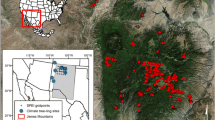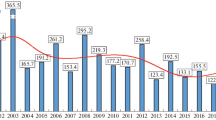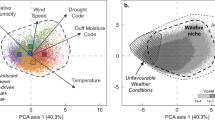Abstract
Wildfires are a common experience in Alaska where, on average, 3,775 km2 burn annually. More than 90% of the area consumed occurs in Interior Alaska, where the summers are relatively warm and dry, and the vegetation consists predominantly of spruce, birch, and cottonwood. Summers with above normal temperatures generate an increased amount of convection, resulting in more thunderstorm development and an amplified number of lightning strikes. The resulting dry conditions facilitate the spread of wildfires started by the lightning. Working with a 55-year dataset of wildfires for Alaska, an increase in the annual area burned was observed. Due to climate change, the last three decades have shown to be warmer than the previous decades. Hence, in the first 28 years of the data, two fires were observed with an area burned greater than 10,000 km2, while there were four in the last 27 years. Correlations between the Palmer Drought Severity Index and the Canadian Drought Code, against both the number of wildfires and the area burned, gave relatively low but in some cases significant correlation values. Special emphasis is given to the fire season of 2004, in which a record of 27,200 km2 burned. These widespread fires were due in large part to the unusual weather situation. Owing to the anticyclonic conditions of the summer of 2004, the composite anomaly of the 500 mb geopotential height showed above normal values. The dominance of a ridge pattern during summer resulted in generally clear skies, high temperatures, and below normal precipitation. Surface observations confirmed this; the summer of 2004 was the warmest and third driest for Interior Alaska in a century of climate observations. The fires lasted throughout the summer and only the snowfalls in September terminated them (at least one regenerated in spring 2005). Smoke from the forest fires affected the air quality. This could be demonstrated by measurements of visibility, fine particle matter, transmissivity of the atmosphere, and CO concentration.

















Similar content being viewed by others
Notes
As these measurements are carried out in miles, we intentionally did not convert them into metric units (1 mile = 1.609 km).
References
Alley WM (1984) The Palmer Drought Severity Index: limitations and assumptions. J Clim Appl Meteorol 23:1100–1109
Balling R, Meyer G, Wells S (1992) Relation of surface climate and burned area in Yellowstone National Park. Agric For Meteorol 60:285–293
Bienniek P (2007) Climate and predictability of Alaska wildfires. M.S. thesis, University of Alaska, p84
Biswas A, Jayaweera K (1976) NOAA-3 satellite observations of thunderstorms in Alaska. Mon Weather Rev 104:292–297
Bradley J, Imbembo S (1985) Automated visibility measurements for airports. American Institute of Aeronautics and Astronautics, Reno, NV
Coen J (2005) Simulation of the Big Elk Fire using coupled atmosphere-fire modeling. J Wild Fire 14:49–59
Court A, Griffiths JF (1992) Thunderstorm climatology. In: Kessler E (ed) Thunderstorm morphology and dynamics, vol 2. University of Oklahoma Press, USA, pp 9–40
Dissing D (2003) Landscape control of thunderstorm development in Interior Alaska. Ph.D Dissertation, University of Alaska, December 2003. p158
Dissing D, Verbyla DL (2003) Spatial patterns of lightning strikes in interior Alaska and their relations to elevation and vegetation. Can J For Res 33:770–782
Duffy PA, Walsh JE, Graham JM, Mann DH, Rupp TS (2005) Impacts of large-scale atmospheric-ocean variability on Alaskan fire season severity. Ecol Appl 15:1317–1330
Eaton F, Wendler G (1983) Some environmental effects of forest fires in interior Alaska. Atmos Environ 17(7):1331–1337
Fauria MM, Johnson EM (2006) Large-scale climatic patterns control large lightning fire occurrence in Canada and Alaska forest regions. J Geophys Res 111:G04008
Girardin M, Tardif J, Flannigan B, Wotton M, Bergeron Y (2004) Trends and periodicities in the Canadian Drought Code and their relationships with atmospheric circulation for the southern Canadian boreal forest. Can J For Res 34:103–119
Guttman NB (1991) A sensitivity analysis of the Palmer Hydrological Drought Index. Water Resour Bull 27(5):797–807
Krider E, Noggle R, Uman M (1976) A gated wideband magnetic direction finder for lightning return strokes. J Appl Meteorol 15:301–306
Krider EP, Noggle AE, Pifer PC, Vance DL (1980) Lightning direction finding systems for forest fire detection. Bull Am Meteorol Soc 61:980–986
Lettau H (1969) A new approach to numerical prediction of monthly evapotranspiration, runoff, and soil moisture storage. Mon Weather Rev 97:691–699
McGuiney E, Shulski M, Wendler G (2004) Alaska lightning climatology and application to wildfire science. Proceedings, Conference on Meteorological Applications of Lightning Data, 85th Annual AMS Meeting, San Diego, CA, electronic version, paper 2.14, p5
Palmer W (1965) Meteorological drought. U.S. Weather Bureau, Research Paper No.45. U.S. Department of Commerce, p58
Reap RM (1986) Evaluation of cloud-to-ground lightning data from the western United States for the 1983–84 summer seasons. J App Meteorol 25:785–799
Reap RM (1991) Climatology characteristics and objective prediction of thunderstorms over Alaska. Weather Forecast 6:309–319
Richmond M, Shy T (2005) An extraordinary summer in the interior of Alaska. Proc. 85th AMS Annual Meeting, P3.24, San Diego, CA, 9–13 January 2005
Rorig ML, Ferguson SR (1999) Characteristics of lightning and wildland fire ignition in the Pacific Northwest. J App Meteorol 38:1565–1575
Rorig ML, Ferguson SR (2002) The 2000 Fire Season: Lightning-Caused Fires. J App Meteorol 41:786–791
Shulski M, Wendler G (2007) The climate of Alaska. University of Alaska Press, Alaska, p216
Skinner WR, Stocks BJ, Martell DL, Bonsal B, Shabbar A (1999) The association between circulation anomalies in the mid-Troposphere and area burned by wildland fire in Canada. Theor Appl Climatol 63:89–105
Skinner WR, Flannigan MD, Stocks BJ, Martell DL, Wotton BM, Todd JB, Mason JA, Logan KA, Bosch EM (2001) A 500 hPa synoptic wildland fire climatology for large Canadian forest fires, 1959–1996. Theor Appl Climatol 71:157–169
Sullivan (1963) Low level convergence and thunderstorms in Alaska. Mon Weather Rev 91:82–92
Stafford J, Wendler G, Curtis J (2000) Temperature and precipitation of Alaska: 50 year trend analyses. Theor Appl Climatol 67:33–44
Swetnam T, Betancourt J (1998) Mesoscale disturbances and ecological response to decadal climatic variability in the American Southwest. J Climate 11:3128–3147
Thornwaite CW (1948) An approach toward a rational classification of climate. Geogr Rev 38:55–94
Turner J (1972) The drought code component of the Canadian Forest Fire Behavior System. Can For Serv Publ 1316
Wendler G, Nicpon P (1975) Low level inversions in Central Alaska. Mon Weather Rev 103(1):33–44
Wendler G, Shulski M (2009) A century of climate change for Fairbanks, Alaska. Arctic 62(3):295–300
Acknowledgments
We would like to thank the following persons: Thor Weatherby provided lightning data and Sue Christensen supplied data on fire starts and area burned, both are with the Alaska Fire Service (AFS). Sharon Alden (AFS) and Heather Angeloff (ACRC) contributed in helpful discussions. Financial support was given by the State of Alaska to the Alaska Climate Research Center (ACRC) and by Vice Chancellor for Research, V. Sharpton.
Author information
Authors and Affiliations
Corresponding author
Rights and permissions
About this article
Cite this article
Wendler, G., Conner, J., Moore, B. et al. Climatology of Alaskan wildfires with special emphasis on the extreme year of 2004. Theor Appl Climatol 104, 459–472 (2011). https://doi.org/10.1007/s00704-010-0357-9
Received:
Accepted:
Published:
Issue Date:
DOI: https://doi.org/10.1007/s00704-010-0357-9




